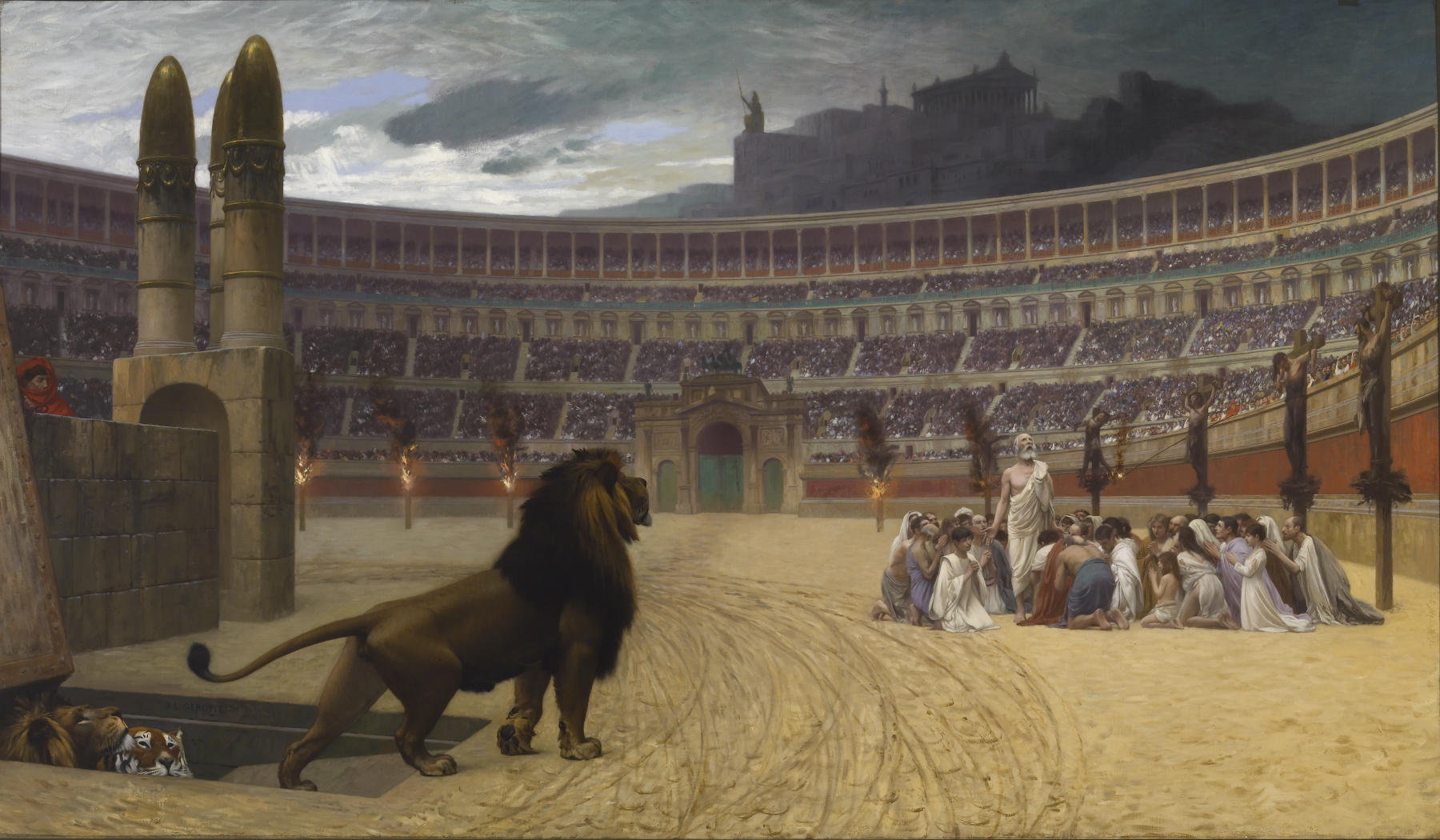The Christian Martyrs' Last Prayer
(18th and 19th Centuries )
William T. Walters commissioned this painting in 1863, but the artist did not deliver it until 20 years later. In a letter to Walters, Gérôme identified the setting as ancient Rome's racecourse, the Circus Maximus. He noted such details as the goal posts and the chariot tracks in the dirt. The seating, however, more closely resembles that of the Colosseum, Rome's amphitheater, in which gladiatorial combats and other spectacles were held. Similarly, the hill in the background surmounted by a colossal statue and a temple is nearer in appearance to the Athenian Acropolis than it is to Rome's Palatine Hill. The artist also commented on the religious fortitude of the victims who were about to suffer martyrdom either by being devoured by the wild beasts or by being smeared with pitch and set ablaze, which also never took place in the Circus Maximus. In this instance, Gérôme, whose paintings were usually admired for their sense of reality, has subordinated historical accuracy to drama.
W. M. Brady & Co, New York, in "Drawings and Oil Sketches 1700-1900," 27 January 2009 - 12 February 2009, No. 21, offers "Study for the 'Death of Caesar," an oil on canvas with pen and ink underdrawing, measuring 7 5/8 x 13 in. (19.5 x 33 cm), which formerly belonged to Maurice Aiccardi, Paris. This sketch may be the one that Theophile Gautier alluded to during a visit to the artist's studio in 1858 (G. Ackerman, Jean-Leon Gerome: Monographie revisee 2000, pp. 240-241).
Inscription
Provenance
Provenance (from the French provenir, 'to come from/forth') is the chronology of the ownership, custody, or location of a historical object. Learn more about provenance at the Walters.
Comissioned by William T. Walters (through George A. Lucas as agent), Baltimore, May 2, 1883 [1] (received in 1883 from the artist); inherited by Henry Walters, Baltimore, 1894; by bequest to Walters Art Museum, 1931.
[1] The Diary of George A. Lucas, p. 563.
Exhibitions
| 2024-2025 | Reinstallation 2024: Art and Process. The Walters Art Museum, Baltimore. |
| 2014-2016 | From Rye to Raphael: The Walters Story. The Walters Art Museum, Baltimore. |
| 2012 | Public Property. |
| 2010-2011 | The Spectacular Art of Jean-Léon Gérôme. J. Paul Getty Museum, Los Angeles; Musee D'Orsay, Paris; Museo Thyssen-Bornemisza, Madrid. |
| 2002-2004 | A Magnificent Age: Masterpieces from the Walters Art Museum, Baltimore. The Walters Art Museum, Baltimore; The Nelson-Atkins Museum of Art, Kansas City; Mint Museum of Art, Charlotte. |
| 1999-2000 | Vive la France! French Treasures from the Middle Ages to Monet. The Walters Art Gallery, Baltimore. |
| 1983 | Nineteenth Century French Salon Paintings from Southern Collections. High Museum of Art, Atlanta; Chrysler Museum of Art, Norfolk; North Carolina Museum of Art, Raleigh; The John and Mable Ringling Museum of Art, Sarasota. |
| 1979 | A Baltimorean in Paris: George A. Lucas, 1860-1909. The Walters Art Gallery, Baltimore. |
| 1976-1977 | Romans and Barbarians. Museum of Fine Arts, Boston, Boston. |
| 1972-1973 | J. L. Gerome. Dayton Art Institute, Dayton; Minneapolis Institute of Art, Minneapolis; The Walters Art Gallery, Baltimore. |
Conservation
| Date | Description | Narrative |
|---|---|---|
| 1/24/1967 | Treatment | varnish removed; coated; lined; loss compensation; inpainted |
| 3/1/1982 | Loan Consideration | examined for loan |
| 10/1/1998 | Loan Consideration | examined for loan |
Geographies
France (Place of Origin)
Measurements
H: 34 5/8 x W: 59 1/8 in. (87.9 x 150.1 cm); Framed H: 55 x W: 79 5/8 x D: 6 3/4 in. (139.7 x 202.25 x 17.15 cm)
Credit Line
Acquired by William T. Walters, 1883
Location in Museum
Not on view
Accession Number
In libraries, galleries, museums, and archives, an accession number is a unique identifier assigned to each object in the collection.
In libraries, galleries, museums, and archives, an accession number is a unique identifier assigned to each object in the collection.
37.113


